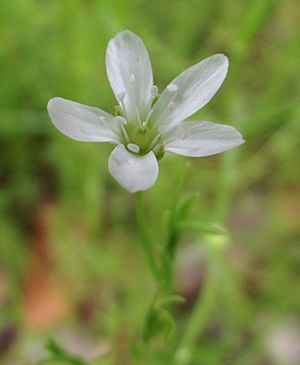Marsh sandwort facts for kids
Quick facts for kids Marsh sandwort |
|
|---|---|
 |
|
| Conservation status | |
| Scientific classification | |
| Genus: |
Arenaria (plant)
|
| Species: |
paludicola
|
Marsh Sandwort (Arenaria paludicola) is a special flowering plant. It is also known as swamp sandwort. This plant belongs to the carnation family. It loves to grow in wet places, like marshes and bogs.
Where It Lives
This plant naturally grows along the west coast of North America. Most of the remaining plants are found in the Central Coast region of California. It is very rare and is listed as a federally endangered species in the United States. This means it is in danger of disappearing forever.
Today, you can find marsh sandwort in two natural spots in San Luis Obispo County, California. People have also planted it in new areas nearby, like Nipomo and Los Osos, to help it survive. It used to grow in Washington, but it might not be there anymore. There are also some unconfirmed reports of it in northern Mexico.
What It Looks Like
The marsh sandwort is a perennial herb. This means it lives for more than two years. It can grow straight up or trail over other plants and objects for support. Its thin stems are smooth and shiny. They can grow up to 90 centimeters (about 3 feet) long. The stems have small bumps called nodes, and sometimes roots can grow from these nodes. Its leaves are very narrow and shaped like a spear.
The plant produces a single white flower. After the flower, a small fruit grows. This fruit is a capsule with tiny teeth. Inside, it holds up to 20 small, brown, kidney-shaped seeds.
Why It's in Danger
The marsh sandwort faces several threats that make it an endangered species.
- Its wetland homes are being destroyed or changed.
- The local water table (the level of water under the ground) is shrinking.
- Human activities, like off-roading, can also harm its habitat.


